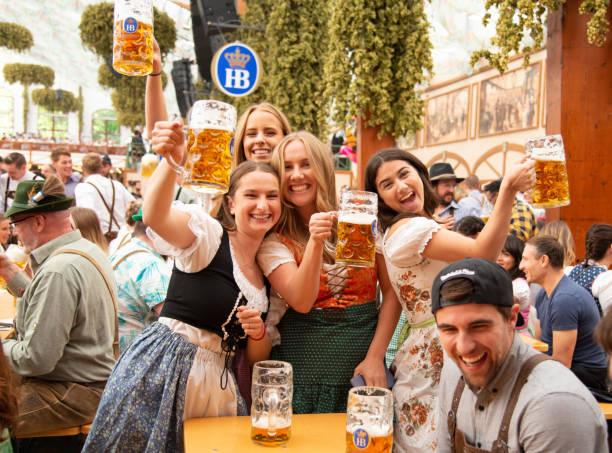Stunning German Traditional Wear
German Traditional Wear, or “Tracht,” is important to German culture and history. Tracht is not just an outfit; it represents the German people’s rich heritage as well as regional diversity. From rural communities, Tracht started out as functional work clothing for farmers and laborers, meant to identify one’s social standing, profession, and local origin.
The best-known types of Tracht are the Dirndl for women and Lederhosen for men. The Dirndl, featuring a close-fitting bodice and long, flowing skirt, embodies refinement and femininity and is usually topped with elaborate embroidery that represents regional customs. By contrast, Lederhosen, which are constructed from leather, embody Bavarian character and tough masculinity. The two pieces have moved beyond their functional origins to become emblems of cultural heritage, particularly when used to attend festivals such as Oktoberfest.
Wearing German Traditional Wear creates a feeling of belonging to and association with one’s background. It enables people to celebrate their heritage while engaging in communal celebrations. Moreover, Tracht provides a visual display of regional divisions within Germany, where every region presents distinct styles and patterns that speak of local traditions and history.
Today, however, there has been renewed interest in traditional German attire, as designers incorporate modern fashion with traditional elements. Not only does this keep cultural heritage alive, but it also provides younger generations with a sense of belonging and encourage them to acknowledge and appreciate their heritage through these timeless outfits.

Overview of Dirndl:German Traditional Wear
The Dirndl is a classic German Traditional Wear that has become the symbol of Bavarian culture and celebration, especially Oktoberfest. Its origins are found in the Alpine parts of Germany, Austria, and Switzerland, and it is distinguished by its distinctive design, which usually features a corset-like bodice, a full skirt, and an apron. The three-piece outfit not only accentuates femininity but is also a medium for regional expression through colors, patterns, and embroidery.
In the past, the Dirndl used to be a functional German Traditional Wear clothing among peasant women for everyday wear in the 16th to 18th centuries. The Dirndl eventually evolved from a functional dress to a stylish one being adopted by the higher class in the late 19th century. At present, the Dirndl is a cultural icon of identity and pride, and it is mostly used during festivities, weddings, and other occasions.
The Dirndl’s design has developed a lot while maintaining its core elements. Contemporary interpretations involve varied fabrics from cotton to silks, with the possibility of blending classic elegance and modern flair. The apron and blouse selection also makes a huge difference in the overall appearance, so it can be worn to suit various occasions.
The Dirndl means more than fashion; it symbolizes tradition and heritage. Putting on a Dirndl creates a sense of community for those celebrating their German heritage, and so it is a lasting emblem of tradition at home and abroad. With increasing numbers putting on this legendary clothing, the Dirndl remains a treasured aspect of German heritage.
Exploring Lederhosen: German Traditional Wear
Lederhosen, literally “leather pants” in German, are ancient German Traditional Wear items that have turned into emblematic symbols of Bavarian identity. Initially, these leather breeches were worn by laborers and farmers in Alpine areas and were created to withstand the rigors of the elements and outdoor activity. The traditional style is usually knee-length shorts or longer versions of the pant, typically having elaborate embroidery and decorative details such as staghorn buttons.
Historically, Lederhosen first appeared in the late Middle Ages and became popular during the entire 18th century. They were especially popular due to their strength, enabling men to perform physical labor without sacrificing comfort. With the advancement of industrialization, the daily usage of Lederhosen decreased; however, they saw a revival in the late 20th century and evolved into stylish clothing that men wore during festivals and other cultural occasions.
Presently, Lederhosen German Traditional Wear have become the trademark of Oktoberfest celebrations, for which they are deemed indispensable wear. Men of any age don these traditional outfits to express their cultural identity and engage in communal revelry. Contemporary Lederhosen exist in different patterns and hues, made from good-quality material like deerskin or goatskin leather. They may be combined with traditional shirts and accessories to create the complete outfit.
The resurgence of interest in Lederhosen German Traditional Wear reflects a broader appreciation for cultural heritage and traditional craftsmanship. Whether worn at folk festivals, weddings, or casual gatherings, Lederhosen continue to embody the spirit of Bavaria, combining tradition with contemporary fashion sensibilities.
Components of a Dirndl and Lederhosen: German Traditional Wear
The Dirndl and Lederhosen German Traditional Wear are classic components of traditional German dress, both consisting of different elements that contribute to their distinct styles.
The Dirndl has three main components:
Bodice:
A close-fitting top emphasizing the waist and bust, bodices may include delicate lacing or buttons. The neck can be square, sweetheart, or V-shaped and usually is made from materials such as cotton, silk, or velvet, depending on the purpose of wear. A bodice should fit tightly and have some structure, resulting in a complementary figure.
Skirt:
The Dirndl skirt is a full, high-waisted skirt that typically falls to the knee or mid-calf. It is gathered around the waist for volume and can be created from a number of different fabrics and patterns. The design of the skirt provides freedom of movement while still looking elegant.
Apron:
Over the skirt, an apron provides further embellishment and may be of varying color and pattern. Tied around the waist, its positioning may even serve as a marker of marital status, with tying on the left side signaling single and tying on the right signaling married. The apron usually has lovely embroidery or print that harmonizes with the overall ensemble.
On the other hand, Lederhosen are composed of:
Pants:
Crafted from thick leather, these are either knee-high shorts or high-waisted trousers. Decorative stitching and ornamentation of a regional kind often characterizes them.
Braces:
Lederhosen are typically worn with over-shoulder braces that add both style and functionality. These braces are often joined across the chest by decorative panels.
Shirt:
A classic shirt is normally worn under Lederhosen, frequently cotton, breathable and with short sleeves.
Both Dirndl and Lederhosen reflect regional pride and cultural heritage, making them essential attire for festivals and celebrations throughout Germany.
Cultural Events Celebrating German Traditional Wear
Cultural festivals honoring German Traditional Wear in Germany are colorful exhibitions of heritage, community, and celebration, with Oktoberfest being the most famous. Celebrated every year in Munich, Oktoberfest draws millions who wear traditional clothing such as Dirndls and Lederhosen, promoting Bavarian culture. The festival began in 1810 as a wedding celebration for the royal family and has since become a worldwide phenomenon, highlighting the significance of traditional clothing in promoting cultural identity.
Besides Oktoberfest, some regional festivals around the year promote traditional dress. Regional harvest festivals and the Schützenfest (marksmen’s festival) have parades in which wearers of Dirndls and Lederhosen strut proudly, highlighting regional traditions and artisanry. Music, dancing, and traditional fare accompany these festivities, evoking a festive environment celebrating German tradition.
Christmas markets throughout Germany also offer a glimpse of traditional wear in practice. Dirndls and Lederhosen are typically worn by tourists as they enjoy holiday treats and holiday decorations. The community aspect of these festivities is evident as individuals gather together to celebrate the culture they share.
Additionally, rural weddings often include traditional fashion, with the brides sometimes selecting stately Dirndls that honor their native backgrounds. Such behavior not only preserves family traditions but also solidifies community bonds.
Overall, German Traditional Wear festivals are significant reminders of Germany’s colorful history and varied regional identities. They promote a feeling of belonging and pride among festival-goers and encourage others to see the beauty and value in genuine German attire.
German Traditional Wear conclusion
Traditional German fashion, especially the Dirndl and Lederhosen, is a colorful manifestation of the rich cultural heritage and regional diversity of the nation. These are not just pieces of clothing; they are imbued with historical values, community pride, and the love of German customs.
Celebrations such as Oktoberfest celebrate the timeless beauty of these dresses, where friends and family unite to party in the company of music, dance, and native cuisine while dressed in their best Dirndls and Lederhosen.
The significance of traditional wear extends beyond festivals; it fosters a sense of unity among individuals who share a connection to their roots. Each region in Germany boasts unique styles of Tracht, showcasing local customs and craftsmanship. From the intricate embroidery of the Dirndl to the rugged charm of Lederhosen, these garments tell stories of resilience and continuity through generations.
Today, traditional German dress continues to transform, incorporating historical aspects into the latest fashion. This ability to change keeps the essence of Tracht alive, opening it up to future generations while paying respect to their heritage.
By donning these classic outfits on special occasions and festivities, individuals not only continue their heritage but also welcome others to marvel at the splendor and tradition of true German garments. Traditional German dress thus proves to be a symbol of a people’s resilience and dedication to commemorating their storied past.
